Whenever I can I love to spend as much time as possible doing yoga. However, on most days when I’m busy and I know I don’t have much time, all I have is 20-30 minutes. In this article, I will explain if doing 20 minutes of yoga is enough to see some results.
In general, 20 minutes of yoga a day is enough to see results because some yoga segments, like sun salutation, elevate heart rate and energy expenditure comparable to other high-intensity activities. It also leads to a decreased body weight and increased lean body mass.

But it also depends on your personal goals. In addition to seeing the list below, please read at the end my recommendations on how to get the most out of your 20 minutes yoga session.
Benefits From Doing 20 Minutes of Yoga a Day
Studies have shown there are several benefits of doing regular yoga, even if it’s just 20 minutes a day. These include weight loss, strength, and performance, flexibility, and mobility, lowered stress and anxiety, better sleep, and mindfulness.
Obviously, there are dozen of benefits to doing regular yoga practice. But here I wanted to pinpoint the most relevant that occur when you just 20 minutes per day.
Benefit #1: Weight loss
In general, 20 minutes of yoga is enough to lose weight because it adds to the energy expenditure and burns calories. During certain yoga class components, like Surya Namaskar, oxygen consumption is elevated resulting in an energy expenditure of 150 kcal.
The study done by Dr. Bhavesh Surendra Mody from Kaiser Permanente Medical Center in San Diego documented the metabolic cost of doing the sun salutation on 6 adults. This was a single study that lasted for 30 minutes (source).
Take a look at the picture below. Here you can see the exact breakdown of the sun salutation sequence. As you can see, the asanas are quite repetitive and require a lot of transitioning from the standing position to the floor position.
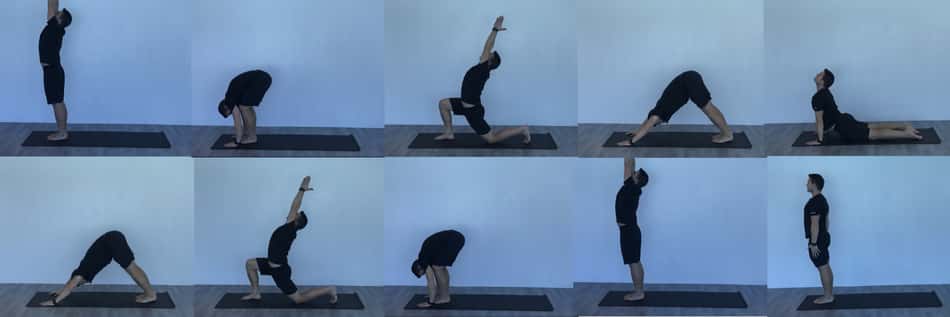
NOTE: In the picture above, you can see me doing sun salutation on one side only. This is because, in some Hatha yoga schools, the full round of sun salutation counts as 1 only when you do the whole sequence twice, one on each leg.
In the table below you can see the exact breakdown of the class.
| Yoga poses | Number |
|---|---|
| Hasta Uttanasana (raised arms) | 1 and 9 |
| Padahastasana (Hand to foot pose) | 2 and 8 |
| Ashwa Sanchalanasana (The equestrian pose) | 3 and 7 |
| Parvatasana (Downward facing dog) | 4 and 6 |
| Bhujangasana (The cobra pose) | 5 |
| Pranamasana (Finish pose) | 1 |
The results
During the study, participants continued to do the following routine for 4 rounds (8 rounds in total). The heart rate was measured throughout the whole class. During the second round, maximal heart rate reached 80%, 84% during Round 3, and 90% during Round 4.
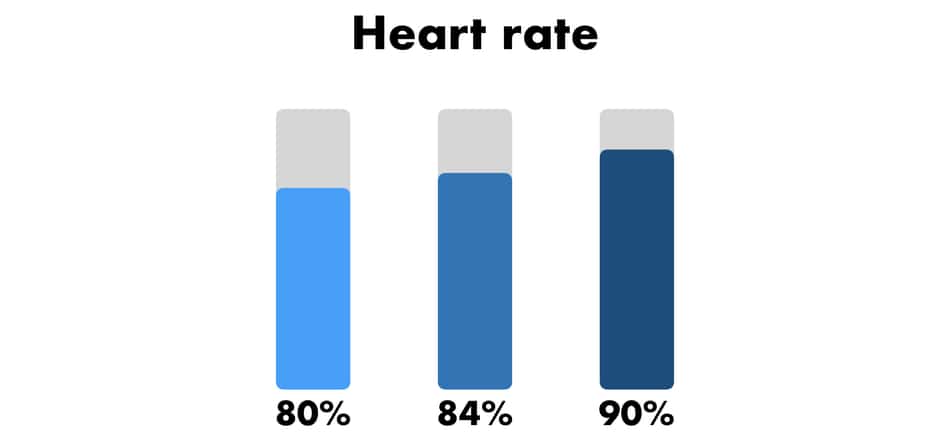
The benefit of elevated heart rate comes in form of increased oxygen consumption, therefore, increased calorie expenditure.
Oxygen consumption, on average, reached 26 ml/kg/min during each round, which accounts for 230 kcal burned in 30 minutes of class. That is 7.6 kcal per minute.
That is great, but what exactly does 7.6 kcal per minute mean? Let’s have a look at how doing 7.6 kcal per minute compares with other popular fitness activities.
| Activity | Calories burned per minute |
|---|---|
| Sit-ups, light effort | 3 kcal |
| Lunges (bodyweight) | 5 kcal |
| Aerobic, low impact | 6 kcal |
| Football, competitive | 10 kcal |
| Pilates, general | 4 kcal |
| Jogging 4 mph (13 min/mile) | 6 kcal |
| Swimming, for pleasure | 7 kcal |
| Lacrosse | 10 kcal |
| Elliptical, level 8, vigorous effort | 7 kcal |
| Boxing, punching bag | 7 kcal |
As you can see in the table above, doing a yoga sun salutation sequence not only can burn a significant amount of calories, but also is comparable with other high-intensity sports.
This shows that doing just 20 minutes of yoga per day often exceeds the calories burned in other popular physical activities.
Learn more: Click here to learn more if you should be doing “yoga before or after running“.
Benefit #2: Control insulin
Doing 20 minutes of yoga a day is enough to influence glucose levels in the blood and control of insulin release. Studies have shown that parasympathetic activity leads to lowering sugar levels in the blood by converting it to glycogen to be stored.
Here’s how it works.
During stressful times, when our sympathetic nervous system (also called fight or flight) is activated, our liver produces more glucose in the process called gluconeogenesis. This freshly made glucose is sent to the blood to be available for energy.
See the graph below.
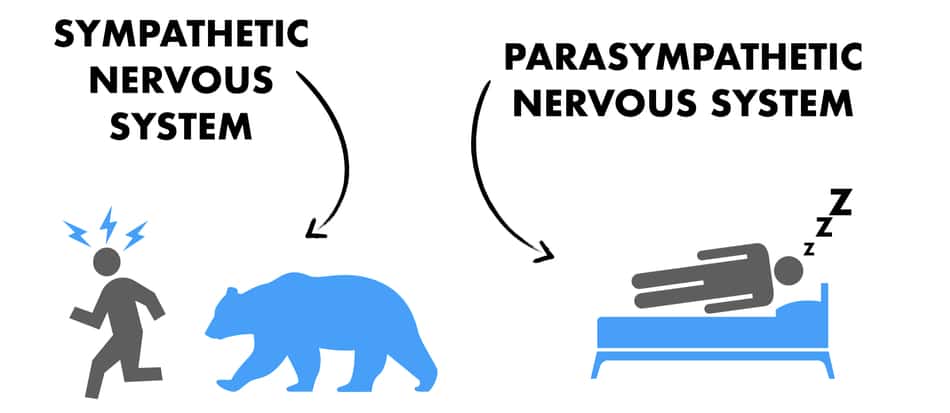
In the result, our blood glucose goes up.
At the same time, our heart needs to maintain high stroke volume to help muscle generate a significant amount of force. So the body also retains water and sodium to maintain elevated blood pressure. This helps to get greater force during muscle contraction.
However, during relaxing times, when the parasympathetic system (also called rest and digest) is activated, our body takes away the glucose from the blood and stores it back in the liver in the form of glycogen.
As the result, our blood glucose goes down (source).
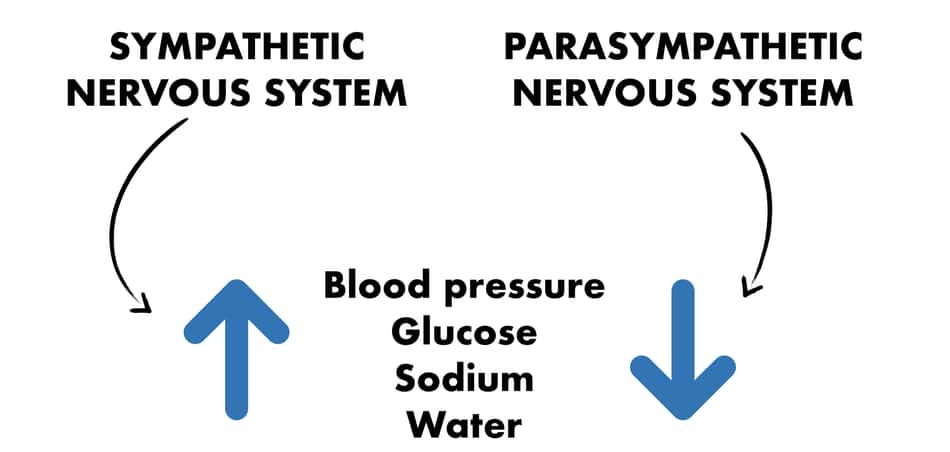
This is also when we see lowered blood pressure and increased urination to eliminate extra water.
Can I lose weight by doing 20 minutes of yoga?
In general, you can lose weight by doing 20 minutes of yoga, as long as you combine it with a calorie deficit. The best effects on body composition will have combining 20 minutes of daily yoga routine with a high-protein diet and mindful eating practices.
That’s not all.
As a general rule, 20 minutes of yoga a day on its own isn’t efficacious to create a negative energy balance. It has to be combined with nutritional intervention. However, yoga has an indirect positive impact on eating behaviors because it regulates mood and balances emotions.
Doing yoga helps to increase the parasympathetic response, which reduces the heart rate and lowers stress levels.
This significantly helps to reduce food cravings and hunger. So doing 20 minutes of yoga a day doesn’t cause direct weight loss, but has an indirect effect on calorie consumption.
People tend to eat more in stressful and emotionally uncomfortable situations. I call it to trigger events where something happened.
We got disturbed, annoyed, worried, or anxious. And even if someone is doing a lot of physical activity, a stressful event can lead to unwanted eating behaviors and overeating.
20 minutes of yoga practice isn’t gonna burn enough calories to outwork the overeating. But, it will help the body to calm down, relax, reduce the amount of sugar in the blood and improve the general mood. This leads to lesser cravings and lowered appetite throughout the day.
So yoga is a skill not only to burn calories but also to down-regulate fight or flight reactions.
Benefit #3: Stress reduction
In general, doing 20 minutes of yoga a day is enough to reduce stress because it creates positive changes in the autonomous nervous system. It works by down-regulating fight or flight response and up-regulating parasympathetic activity.
One study done by Dr. Ipek Ensari, an associate research scientist from Columbia University compared the effects of doing 20 minutes yoga session with 20 minutes of walking on stress and stress-related markers (source).
The results showed that both groups experienced similar results, however, the yoga group had an insignificantly better result.
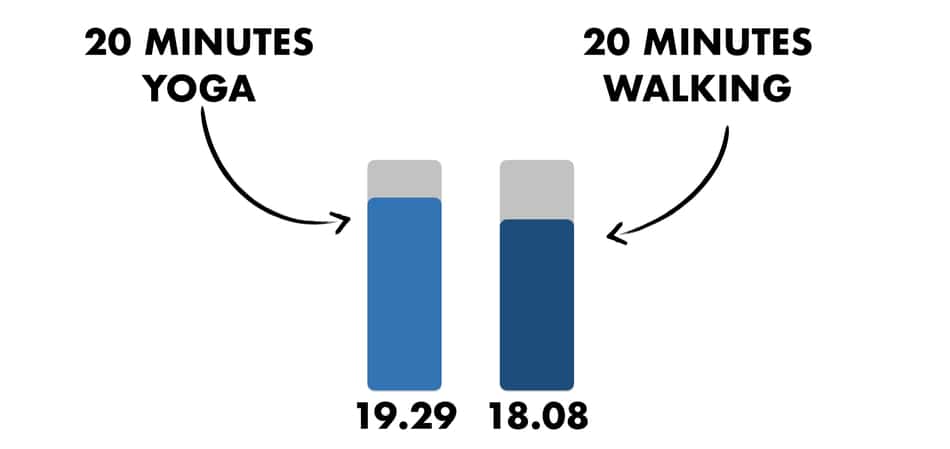
Another study done by Dr. Nobuhiko Eda from the Waseda University in Japan documented the effects of yoga on the salivary stress hormones and cardiac autonomic nervous system on 10 adults who have never practiced yoga before (source).
To be more specific, the researchers were measuring:
- salivary testosterone level
- testosterone/cortisol ratio
- salivary cortisol level
Which are all indicators of parasympathetic activity.
The study was divided into two groups, yoga, and control. The yoga group performed a session of Hatha yoga, where the control group was sitting in a relaxed position.
The results
The results showed that a single yoga session was enough to significantly reduce cortisol levels, increase testosterone levels and improve the ratio of testosterone to cortisol.
Here below you can see the table with the results for the yoga group.
| Time | Testosterone | Cortisol | T/C ratio |
|---|---|---|---|
| Before | 179.7 | 1.71 | 124.3 |
| After | 178.1 | 1.06 | 209 |
| 60 min after | 182.1 | 1.14 | 258.5 |
| 120 min after | 193.7 | 0.82 | 261.2 |
That’s not all.
The researchers also looked at the changes in other aspects of stress like tension, anxiety, depression, anger, fatigue, or confusion.
In the table below you can see the results for the yoga group on each of those markers.
| Markers | Before | After | 60 min after | 120 min after |
|---|---|---|---|---|
| Anxiety | 39.9 | 35.4 | 34.9 | 35.1 |
| Depression | 44.8 | 43.3 | 42.6 | 42.0 |
| Anger | 40.5 | 38.7 | 38.4 | 37.8 |
| Fatigue | 41.5 | 43.5 | 42.3 | 40.9 |
| Confusion | 47.6 | 45.4 | 45.3 | 45.4 |
As you can see, every single aspect of stress-related markers was improved after a single yoga session. Of course.
Of course, over time with the consistency of activation of parasympathetic response, the markers can significantly reduce. This means the dominant activity of the parasympathetic nervous system will also start to positively affect our brain. That is due to neuroplasticity.
The researcher Dr. Neha P. Gothe from the University of Illinois concluded in one of her studies that
“Studies demonstrate a positive effect of yoga practice on the structure and/or function of the hippocampus, amygdala, prefrontal cortex, cingulate cortex and brain networks including the default mode network”
(source)
This means the long-term effects of yoga practice have the ability to change not only how the brain responds, but also the entire brain structure.
It also helps to down-regulate the sympathetic nervous system, which lowers the stress and helps with converting glucose into glycogen to be stored in the muscle and liver.
20 Minute of Yoga a Day Routine
I want to show you the exact routine that I do when I have only 20 minutes of yoga. I prefer to spend the whole 60 minutes, however, when I’m crunched with time, something is better than nothing.
I like to practice Ashtanga yoga because it involves a lot of transitions that force you to be constantly moving from the floor. It also has several upper body asanas so it really works on my chest, shoulders, and arms.
Obviously, I’m not flexible enough to be able to complete the whole primary series, but that’s ok. For the times when I really struggle with time, sun salutation is perfectly fine.
Another thing that I like about Ashtanga is the breathing. Each time you change the sequence, you need to either inhale or exhale. This practice makes you focus on the moment. I like it because it forces me to be present in the actual moment of practice.
How to breathe in ashtanga yoga? In general, in Ashtanga yoga, you breathe in the vinyasa “breathing/moving” system. Each pose flows into the next using breathing and the bandhas. With each asana, you change your breathe and as you transition to the next pose, you change the breathing with you.
Here is the exact breakdown of the sequence in Ashtanga yoga sun salutation B with an emphasis on breathing.
| Nr | Position | Breathing pattern |
|---|---|---|
| 1 | Utkatasana | Inhale |
| 2 | Uttanasana | Exhale |
| 3 | Ardha uttanasana | Inhale |
| 4 | Chaturanga dandasana | Exhale |
| 5 | Urdhva mukha svanasana | Inhale |
| 6 | Adno mukha svanasana | Exhale |
| 7 | Virabhadrasana A (right leg) | Inhale |
| 8 | Chaturanga dandasana | Exhale |
| 9 | Urdhva mukha svanasana | Inhale |
| 10 | Adno mukha svanasana | Exhale |
| 11 | Virabhadrasana B (left leg) | Inhale |
| 12 | Chaturanga dandasana | Exhale |
| 13 | Urdhva mukha svanasana | Inhale |
| 14 | Adno mukha svanasana | Exhale |
| 15 | Pancadasana | Inhale |
| 16 | Uttanasana | Exhale |
| 17 | Utkatasana | Inhale |
| 18 | Samastithi | Exhale |
Here you can see the video of my Ashtanga yoga sun salutation.
As you can see, each position comes with a slow “pause” where I either catch my breath or exhale. In one round you have 18 moves with constant moving up and down the floor.
When I do yoga for 20 minutes I want to squeeze in as many rounds as possible. I think my current best is 33. But don’t think I always go for a high number. Absolutely not. In fact, this happened only a few times. Normally I do take my time.
- Rounds 1-3
Usually in the first three rounds, I feel stiff like a wooden plank. My calves do feel like they have never stretched before, my shoulders feel stiff and when I do cobra pose (Urdhva mukha svanasana) I cannot reach far. In fact, I cannot sometimes see the ceiling.
- Rounds 4-7
This is when it gets interesting. I have more range of motion in my ankle as my calves and whole gastrocnemius-soleus complex loosen up and can reach further down to the floor during the downward-facing dog position (Adno mukha svanasana). I also feel a little extra range of motion in my shoulders.
- Rounds 8-10
Here I can definitely feel awake. My heart rate is already elevated, my feet feel more centered and I can open my hips wider. I also feel less tension in my legs in general as it gets easier to transition from one position to another.
- Rounds 11-14
Here I feel like I already reached my full range of motion. I can almost reach my heels towards the floor and my shoulders can sink in towards the ground much easier. From this moment onwards, every single round is more about cardio and less about flexibility.
NOTE: Normally, on the last downward facing dog (Adno mukha svanasana) of each round I stay and hold the pose for around 5 breaths. During this time I focus on deep breathing and push my heels down to the floor.
Learn more: Click here to learn more about the benefits of doing “yoga 2 hours a day“.
Conclusion
15-20 minutes of yoga is enough to get a lot of benefits. Even if you just spend your time doing simple sun salutation, your body can really elevate your heart rate and ramp up energy expenditure.
However, if your goal is to relax and cool down after a long day, feel free to follow any 20 minutes of yoga protocol that stretches most of the muscle groups.
